牛津译林版英语必修二Unit3Task2教案
译林版高一英语必修第二册(2019版)_Unit3_(Revision)_课堂实录配套课件
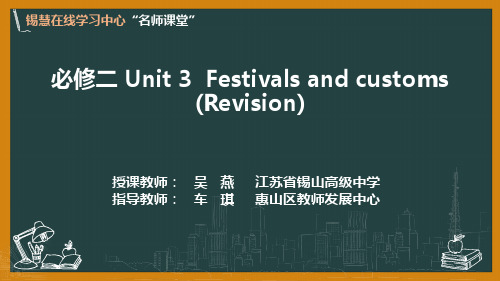
锡慧在线学习中心“名师课堂”
Now Li Ping is writing an e-mail, introducing the Spring Festival to Jack.
锡慧在线学习中心“名师课堂”
Traditional Chinese festivals
the Qingming Festival the Dragon Boat Festival the Mid-Autumn Festival the Double Ninth Festival the Laba Festival
锡慧在线学习中心“名师课堂”
During his trip abroad, Li Ping has made friends with an English boy named Jack. Last week Jack sent Li Ping an e-mail, asking for information about traditional Chinese festivals. What do you know about traditional Chinese festivals?
锡慧在线学习中心“名师课堂”
Entry 3 La Tomatina
28th August, Spain La Tomatina is an __an_n_u_a_l__(一年一度的) tomato fight festival c_e_l_e_b_ra_t_e_d (庆祝) in the small town of Bunol in Spain. People from all over the world filled the small town for this special _o_cc_a_s_i_o_n_(时刻). At around 11:00 in the morning, the tomato trucks made their _e_n_t_ra_n_c_e_(进入) and stopped in the town center. Once the fight began, the _m__e_rr_y_(欢乐的) crowd rushed to the trucks to pick up tomatoes and threw them at each other. People were caught up in the fight for about half an hour, and by the time it finished, around 150, 000 kilograms of tomatoes had covered Bunol. No wonder fire e_n_g_i_n_es_(消防车) were needed to wash the streets after the fight – the town looked like it had beend_e_c_o_ra_t_e_d (装饰) with red paint! Luckily, the _a_c_id__(酸) in the tomato helped make everything really clean.
牛津译林版(2019)必修 第二册 Unit3 Reading2 教案
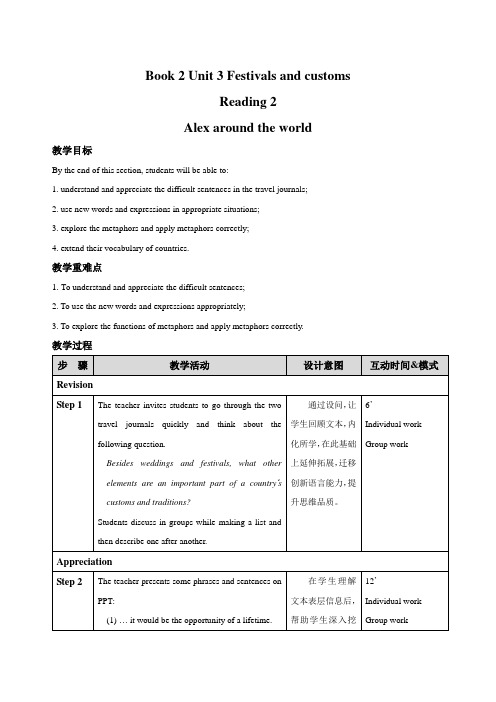
步骤
教学活动
设计意图
互动时间&模式
Revision
Step 1
The teacher invites students to go through the two travel journals quickly and think about the following question.
Besides weddings and festivals, what other elements are n important part of a country’s customs and traditions?
(3)Why did the author say “I have two left feet …and both of them hurt”?
The teacher encourages students to think carefully and guides them toexpresstheir understandings.
2’
(3)I have two left feet … and both of them hurt!
Students are invited to locate these in the journal and read them carefully by themselves and answer the following questions.
(4) I was so caught up in the partyfeverthat I hardly noticed five hours fly by!
Students are invited to locate these in the journal and read them carefully by themselves and answer the following questions.
2019年译林牛津版必修二Unit3 Task课件(共46张PPT)
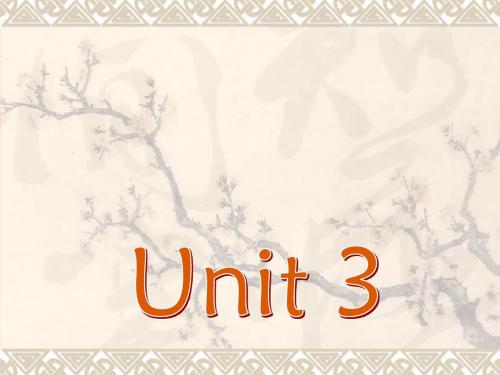
street number Ye Ping lives at 798 Jiangsu Road.
time Ivy is playing tennis at six o’clock this evening.
134 1,949
one hundred and thirty-four
one thousand, nine hundred and forty-nine
23,876
twenty three thousand, eight hundred and seventy-six
2,234,567
two million, two hundred and thirty-four thousand, five hundred and sixty-seven
Experience: your past jobs, company names, location and position held for past jobs References: names of the persons who once worked or studied together with you and their contact information Other: honours you have got, hobbies and interests
注意:When we talk about the date or when we want to talk about something in order, we use ordinal numbers. 当我们谈论日期或当我们按顺序谈论事 情时,我们使用序数词。
【教案】牛津译林版高中英语必修二Unit3Amazingpeoplegrammar教案
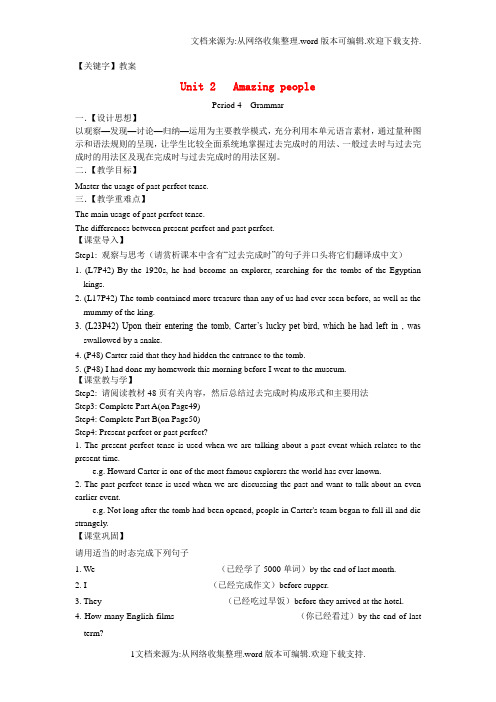
【关键字】教案Unit 2 Amazing peoplePeriod 4 Grammar一.【设计思想】以观察—发现—讨论—归纳—运用为主要教学模式,充分利用本单元语言素材,通过量种图示和语法规则的呈现,让学生比较全面系统地掌握过去完成时的用法、一般过去时与过去完成时的用法区及现在完成时与过去完成时的用法区别。
二.【教学目标】Master the usage of past perfect tense.三.【教学重难点】The main usage of past perfect tense.The differences between present perfect and past perfect.【课堂导入】Step1: 观察与思考(请赏析课本中含有“过去完成时”的句子并口头将它们翻译成中文)1. (L7P42) By the 1920s, he had become an explorer, searching for the tombs of the Egyptian kings.2. (L17P42) The tomb contained more treasure than any of us had ever seen before, as well as the mummy of the king.3. (L23P42) Upon their entering the tomb, Carter’s lucky pet bird, which he had left in , was swallowed by a snake.4. (P48) Carter said that they had hidden the entrance to the tomb.5. (P48) I had done my homework this morning before I went to the museum.【课堂教与学】Step2: 请阅读教材48页有关内容,然后总结过去完成时构成形式和主要用法Step3: Complete Part A(on Page49)Step4: Complete Part B(on Page50)Step4: Present perfect or past perfect?1. The present perfect tense is used when we are talking about a past event which relates to the present time.e.g. Howard Carter is one of the most famous explorers the world has ever known.2. The past perfect tense is used when we are discussing the past and want to talk about an even earlier event.e.g. Not long after the tomb had been opened, people in Carter's team began to fall ill and die strangely.【课堂巩固】请用适当的时态完成下列句子1. We (已经学了5000单词)by the end of last month.2. I (已经完成作文)before supper.3. They (已经吃过早饭)before they arrived at the hotel.4. How many English films (你已经看过)by the end of last term?5. He said he (从未见过)such an exciting match before.6. Most of the guests (已经离开)when he arrived at the party.7. When Jack arrived, he learned Mary (已经离开)for almost an hour.8. She didn’t go to bed until she (已经完成)the work.9. It was the third time that he (失业)that year.10. As soon as I saw a lady getting off the bus, I knew it was she, for I _____________________(以前见过她).【知识小结】A. 过去完成时的构成形式:had + 过去分词请用“过去完成时”将下列句子翻译成英文1. 当我醒来时,雨已经停了。
高中译林牛津英语模块二Unit3教案
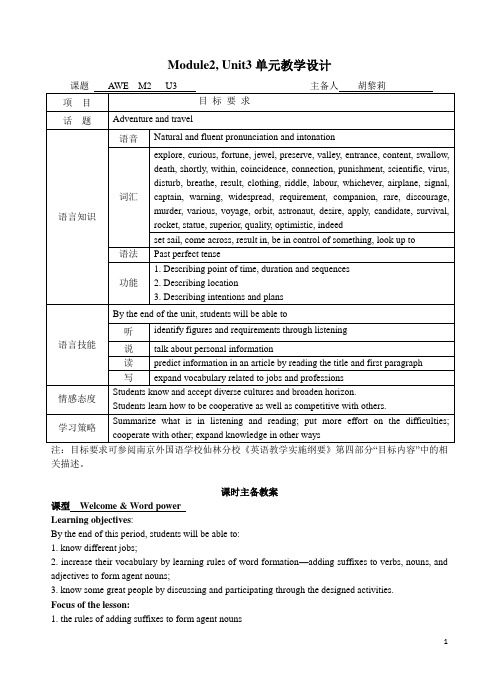
Module2, Unit3单元教学设计注:目标要求可参阅南京外国语学校仙林分校《英语教学实施纲要》第四部分“目标内容”中的相关描述。
课时主备教案课型Welcome & Word powerLearning objectives:By the end of this period, students will be able to:1. know different jobs;2. increase their vocabulary by learning rules of word formation—adding suffixes to verbs, nouns, and adjectives to form agent nouns;3. know some great people by discussing and participating through the designed activities.Focus of the lesson:1. the rules of adding suffixes to form agent nouns2. proper expressions of students‟ opinions about who they consider heroes/heroines Predicted area of difficulties:the rules of adding suffixes to form agent nounsLearning aids:1.PPT2.blackboardLearning procedures:课型Reading(I)Learning objectives:By the end of this period, students will be able to1.predict the contents of a passage based on the title, the first paragraph and some adjectives;2. grasp the main idea of each paragraph accurately;3. think critically by raising some questions concerning the passage.4. know more about the mummies, the Pyramids and Egypt through sharing information. Focus of the lesson:1. the new words and phrases in this article2. the main idea of each paragraphPredicted area of difficulties:the comprehension about how the deaths happened Learning methods:1. PPT2. blackboardLearning procedures:课型Reading(II)Learning objectives:By the end of this period, students will be able to1. write out the transformation and phrases of the key words correctly;2. use the key words properly in relevant tasks;3. raise the awareness of learning new words or phrases in a context. Focus of the lesson:1. usage of the key words2. usage of the key patternsPredicted area of difficulties:the usage of the phrase …by + time adverbial‟ …result in‟ and so on Learning aids:1. PPT2. blackboardLearning procedures:课型Grammar & UsageLearning objectives:By the end of this period, students will be able to1.understand the grammatical meanings of the past perfect tense;2.employ the past perfect tense by doing various exercises.Focus of the lesson:the understanding of the grammatical meaning of the tense.Predicted area of difficulties:1. the usage of the past perfect tense in proper situations2. the differences between the past perfect tense and the simple perfect tense Learning aids:1. PPT2. blackboardLearning procedures:课型TaskLearning objectives:By the end of this lesson, students will be able to:1. learn what a CV is and the features of a CV.2. identify specific numbers when listening.3. know how to write a biographical article by grouping and organizing information.Focus of the lesson:1. the feature of a CV2. how to write a biographical articlePredicted learning difficulties:1. the difficulty of identifying specific numbers and how to write the numbers in different situations2. the difficulty of writing a biographical articleLearning aids:1. PPT2. computerLearning procedures:课型ProjectLearning objectives:By the end of this period, students will be able to:1. get detailed information about Yang Liwei.2. improve the ability of organizing and analyzing personal information/ CV .3. write an article about a person according to a CV.Focus of the lesson:1. a comparison of main characteristics between Zhongdian and Shangri-la2. design of a travel leafletPredicted learning difficulties:1. design of a travel leafletLearning aids:1. PPT2. blackboard3. paperLearning procedures:。
牛津译林版高中英语必修二Unit3AmazingpeopleReading2教学设计
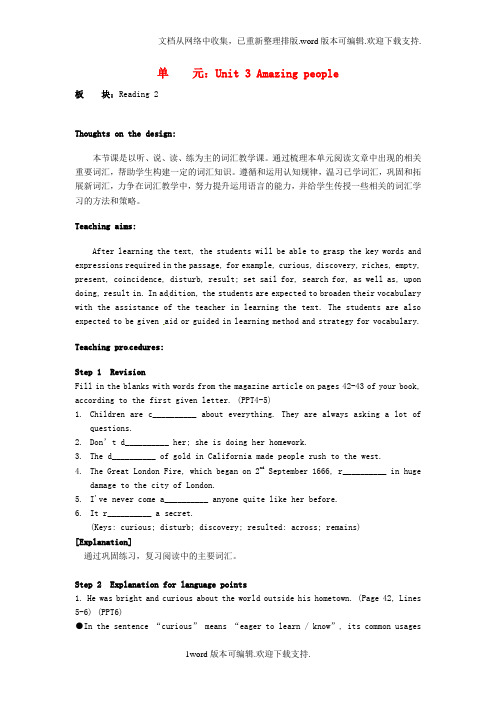
单元:Unit 3 Amazing people板块:Reading 2Thoughts on the design:本节课是以听、说、读、练为主的词汇教学课。
通过梳理本单元阅读文章中出现的相关重要词汇,帮助学生构建一定的词汇知识。
遵循和运用认知规律,温习已学词汇,巩固和拓展新词汇,力争在词汇教学中,努力提升运用语言的能力,并给学生传授一些相关的词汇学习的方法和策略。
Teaching aims:After learning the text, the students will be able to grasp the key words and expressions required in the passage, for example, curious, discovery, riches, empty, present, coincidence, disturb, result; set sail for, search for, as well as, upon doing, result in. In ad dition, the students are expected to broaden their vocabulary with the assistance of the teacher in learning the text. The students are also expected to be given aid or guided in learning method and strategy for vocabulary.Teaching pro cedures:Step 1 RevisionFill in the blanks with words from the magazine article on pages 42-43 of your book, according to the first given letter. (PPT4-5)1.Children are c__________ about everything. They are always asking a lot ofquestions.2.Don’t d__________ her; she is doing her homework.3.The d__________ of gold in California made people rush to the west.4.The Great London Fire, which began on 2nd September 1666, r__________ in hugedamage to the city of London.5.I've never come a__________ anyone quite like her before.6.It r__________ a secret.(Keys: curious; disturb; discovery; resulted: across; remains) [Explanation]通过巩固练习,复习阅读中的主要词汇。
牛津译林版高中英语必修2精选教案Unit 3 Amazing peopleword power
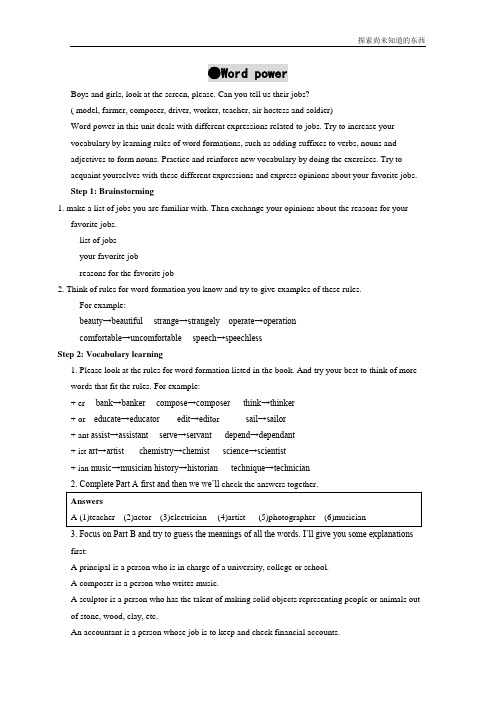
●Word powerBoys and girls, look at the screen, please. Can you tell us their jobs?( model, farmer, composer, driver, worker, teacher, air hostess and soldier)Word power in this unit deals with different expressions related to jobs. Try to increase yourvocabulary by learning rules of word formations, such as adding suffixes to verbs, nouns andadjectives to form nouns. Practice and reinforce new vocabulary by doing the exercises. Try to acquaint yourselves with these different expressions and express opinions about your favorite jobs.Step 1: Brainstorming1. make a list of jobs you are familiar with. Then exchange your opinions about the reasons for yourfavorite jobs.list of jobs__________________your favorite job _______________reasons for the favorite job______________2. Think of rules for word formation you know and try to give examples of these rules.For example:beauty→beautiful strange→strangely operate→operationcomfortable→uncomfortable speech→speechlessStep 2: Vocabulary learning1. Please look at the rules for word formation listed in the book. And try your best to think of morewords that fit the rules. For example:+ er bank→banker compose→composer think→thinker+ or educate→educator edit→edit or sail→sailor+ ant assist→assistant serve→servant depend→dependant+ ist art→artist chemistry→chemist science→scientist+ ian music→musician history→historian technique→technician2. Complete Part A first and then we we’ll check the answers together.3. Focus on Part B and try to guess the meanings of all the words. I’ll give you some explanationsfirst:A principal is a person who is in charge of a university, college or school.A composer is a person who writes music.A sculptor is a person who has the talent of making solid objects representing people or animals outof stone, wood, clay, etc.An accountant is a person whose job is to keep and check financial accounts.4. Complete Part B together. Any different answers are welcome.Step 3: Vocabulary extension1. Focus on Part C and complete it individually. Don’t forget to give your reasons for the jobs you choose. You may provide as many reasons as possible.2. Please think about the different qualities we have to possess in order to take up a specific job. As you mentioned, you’d like to be a teacher. Then, in your opinion, what qualities should you possess in order to be a teacher? Do you think it’s easy to be a good teacher?3. Please read the article in Part A in Writing on page 103 in Workbook to learn how to write an article to describe a person. Then do Part B on the same page.Step 4: ExercisesA. Give the noun form of the following word to express the occupation or station.(1) examine (2) art (3) build (4) chemistry (5) conduct (6) dance(7) design (8) beg (9) dive (10) invent (11) translate (12) physics (13) lead (14) library (15) employ (16) piano (17) prison (18) sail(19) serve (20) discover (21) technique (22) win (23) visit (24) operateB. Choose the proper words for the blanks.(1) west, western, westernerSome _______ forms of greeting are not used in the East.A ______ may find that traveling in Asian counties is quite an experience.(2) compose, composer, compositionBeethoven was one of the greatest ______ in the world.He played a piano piece of his own _______.(3) advertise, advertiser, advertisementIf you want to sell your house, you may put an ______ in a newspaper.Factories often ______ their goods on TV or over the radio.An _______ always uses various means to attract the public attention.(4) create, creative, creation, creatorThe invention of steam engine led to the ______ of modern machine.It is essential to develop a student’s _______ ability.The people are the _______ of history.。
译林牛津版高中英语必修第二册-UNIT 3 Integrated skills 2教学课件
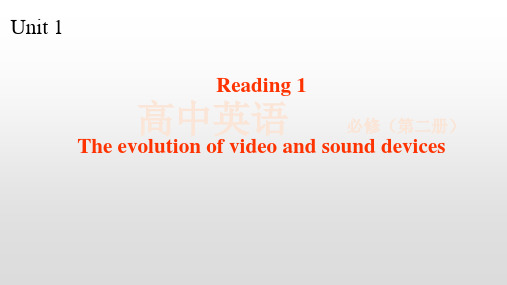
Planning
Learning about the language
• Organize your points with first of all, moreover, finally/last but not least, etc. if you give more than one way to promote traditional Chinese festivals.
• Use imperative sentences to call for action. Make them short and powerful.
Drafting
Promoting traditional Chinese festivals Traditional Chinese festivals are an important part of Chinese culture. We must ____________________________.
When writing an article to promote traditional Chinese festivals, you can follow the structure below: • State the importance of promoting traditional Chinese festivals. • Offer ways to promote traditional Chinese festivals. • Make a call for action and description of a positive result.
Revision
Why should we promote the traditional Chinese festivals? How can we promote the traditional Chinese festivals?
英语必修ⅱ译林牛津版u3task教案

备课时间2012 年 12 月 25 日上课时间第周周月日班级节次课题M2U3 Task 总课时数第节教学目标 1.to help students review some kinds of figures and master the forms of figures as well as the way to listen to the figures.2.to enhance students’ overall abilities and improve their integrated skills1.教学重难点help students learn how to make a note of figures2.Make students learn how to conduct an interview, how to analysestatistics and how to write a biographical article based on the interview 教学参考Reference book授课方法Reading and practice 教学辅助手段多媒体专用教室教学过程设计教学二次备课Step 1 Lead-inAsk students some questions related to the figures:1. How old are you ?2.Which floor are you on at school?3. What is the date today?4. How old is your father?Step 2 Skills building 1: Listening for figuresA.Ask students to read directions on P52 to get a general idea of what is tobe learnt.B.Help students to understand the following:1. Kinds of figures:Cardinal and Ordinal numbersone _______two _______Three ________four ________fourteen _________forty _________seventeen _________seventy _________Free talkWrite down the right words教学过程设计教学二次备课Plural form of figuresin the twenties _______________in the thirties _______________in the forties ________________Practise reading some figures and Game-play•25,000 108,000 32,000 10,200,200•十四点三十分五十周年五百万四千八十万六百C. Do listening exercise on P 52.D. Part A in step 1 and finish Part B according to Part A.Step 3 Skills building 3 : Organizing informationA. Ask students to read the guidelines and understand how to group information into different groups:3 important sections1.Introduction: Who we are going to write about and why we are writing about him/her2. Body: Details about the person ( what he/she did; what he/she said, his/her opinions, the facts, the statistics, etc.)3. Conclusion: The important result of his/her deed and what people think about him/her)B. Do part A On P56 and Part B on P57C. Ask students to write a biographical article in accordance to what has been mastered.Read the figuresLearn how to writea biographical article课外作业Write a biographical article in accordance to what has been mastered.教学小结。
Unit 2《Language》Task教案2(牛津译林版必修3)
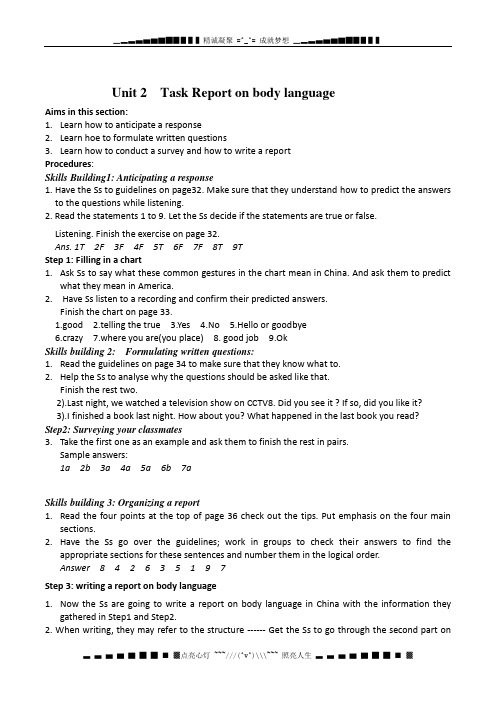
Unit 2 Task Report on body languageAims in this section:1.Learn how to anticipate a response2.Learn hoe to formulate written questions3.Learn how to conduct a survey and how to write a reportProcedures:Skills Building1: Anticipating a response1. Have the Ss to guidelines on page32. Make sure that they understand how to predict the answers to the questions while listening.2. Read the statements 1 to 9. Let the Ss decide if the statements are true or false.Listening. Finish the exercise on page 32.Ans. 1T 2F 3F 4F 5T 6F 7F 8T 9TStep 1: Filling in a chart1.Ask Ss to say what these common gestures in the chart mean in China. And ask them to predictwhat they mean in America.2.Have Ss listen to a recording and confirm their predicted answers.Finish the chart on page 33.1.good2.telling the true3.Yes4.No5.Hello or goodbye6.crazy7.where you are(you place)8. good job9.OkSkills building 2: Formulating written questions:1.Read the guidelines on page 34 to make sure that they know what to.2.Help the Ss to analyse why the questions should be asked like that.Finish the rest two.2).Last night, we watched a television show on CCTV8. Did you see it ? If so, did you like it?3).I finished a book last night. How about you? What happened in the last book you read?Step2: Surveying your classmates3.Take the first one as an example and ask them to finish the rest in pairs.Sample answers:1a 2b 3a 4a 5a 6b 7aSkills building 3: Organizing a report1.Read the four points at the top of page 36 check out the tips. Put emphasis on the four mainsections.2.Have the Ss go over the guidelines; work in groups to check their answers to find theappropriate sections for these sentences and number them in the logical order.Answer 8 4 2 6 3 5 1 9 7Step 3: writing a report on body language1.Now the Ss are going to write a report on body language in China with the information theygathered in Step1 and Step2.2. When writing, they may refer to the structure ------Get the Ss to go through the second part onpage37 to get the general idea for each section.IntroductionProcedures/MethodResults/FindingsConclusionHomework:1.Read A on page 992.Finish B on Page 99。
高一英语牛津译林版(2020)必修二 Unit 3 教案

Book2 Unit3 Integrated skillsPromoting traditional Chinese FestivalsTeaching DesignLearning objectives:After the class, the students are expected to1. Know the reasons for and ways of promoting of traditional Chinese festivals;2.Write an article promoting traditional Chinese festivals under guidance.3. Have a deeper understanding of Chinese traditional festivals and cultures.Difficult points:During the teaching procedure, there may exist such challenges, such as1. Having the students grasp the reasons for promoting traditional Chinese festivals;2. Guiding the students to use some newly-learnt vocabulary related to the festival promotion. Teaching procedures:Step 1: Lead- inIntroduce the topic.设计意图:展示中国传统节日,铺垫教学内容(what will be learnt),激活学生的背景知识。
Step 2: ReadingActivity①Have students read the website article in Part A and answer the following questions.Q1: What challenges are traditional Chinese Festivalsfacing?Q2: What’s the writer’s attitude towards traditional Chinese festivals?Q3: What are the reasons of promoting traditional Chinese festivals?Activity②Deal with sentences and vocabulary related to the reasons for promoting Chinese festivals1设计意图:阅读反映中国传统节日的文章,了解现状(what the situation is )。
高中英语Unit 2 Language-Task 教案 译林必修3 教案
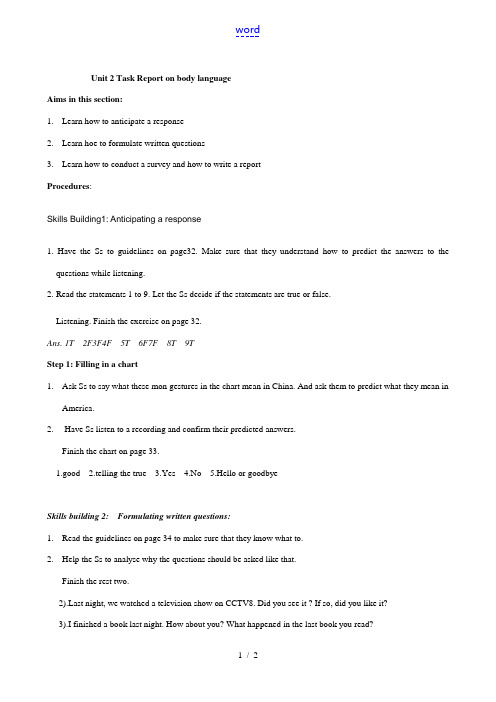
Unit 2 Task Report on body languageAims in this section:1.Learn how to anticipate a response2.Learn hoe to formulate written questions3.Learn how to conduct a survey and how to write a reportProcedures:Skills Building1: Anticipating a response1. Have the Ss to guidelines on page32. Make sure that they understand how to predict the answers to the questions while listening.2. Read the statements 1 to 9. Let the Ss decide if the statements are true or false.Listening. Finish the exercise on page 32.Ans. 1T 2F3F4F 5T 6F7F 8T 9TStep 1: Filling in a chart1.Ask Ss to say what these mon gestures in the chart mean in China. And ask them to predict what they mean inAmerica.2.Have Ss listen to a recording and confirm their predicted answers.Finish the chart on page 33.1.good2.telling the true3.Yes4.No5.Hello or goodbyeSkills building 2: Formulating written questions:1.Read the guidelines on page 34 to make sure that they know what to.2.Help the Ss to analyse why the questions should be asked like that.Finish the rest two.2).Last night, we watched a television show on CCTV8. Did you see it ? If so, did you like it?3).I finished a book last night. How about you? What happened in the last book you read?Step2: Surveying your classmates3.Take the first one as an example and ask them to finish the rest in pairs.Sample answers:1a 2b 3a4a5a 6b 7aSkills building 3: Organizing a report1.Read the four points at the top of page 36 check out the tips. Put emphasis on the four main sections.2.Have the Ss go over the guidelines; work in groups to check their answers to find the appropriate sections forthese sentences and number them in the logical order.Answer 8 4 2 6 3 5 1 9 7Step 3: writing a report on body language1.Now the Ss are going to write a report on body language in China with the information they gathered in Step1and Step2.2. When writing, they may refer to the structure ------Get the Ss to go through the second part on page37 to get the general idea for each section.IntroductionProcedures/MethodResults/FindingsConclusionHomework:1.Read A on page 992.Finish B on Page 99。
高中英语 Unit2 Language Task教学设计2 牛津译林版必修3
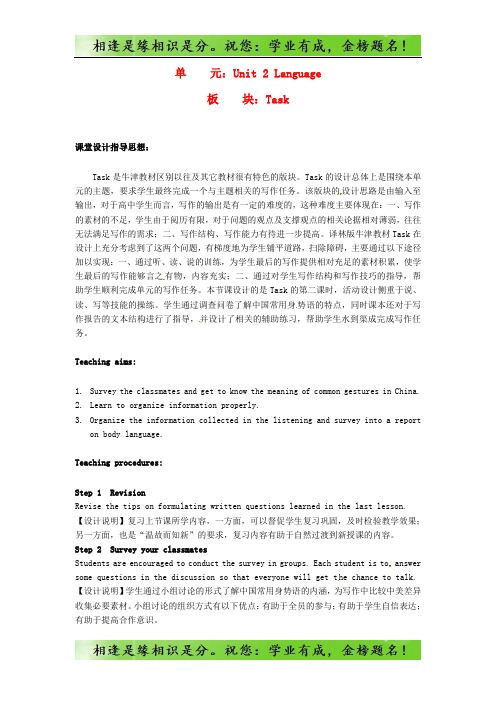
单元:Unit 2 Language板块:Task课堂设计指导思想:Task是牛津教材区别以往及其它教材很有特色的版块。
Task的设计总体上是围绕本单元的主题,要求学生最终完成一个与主题相关的写作任务。
该版块的设计思路是由输入至输出,对于高中学生而言,写作的输出是有一定的难度的,这种难度主要体现在:一、写作的素材的不足,学生由于阅历有限,对于问题的观点及支撑观点的相关论据相对薄弱,往往无法满足写作的需求;二、写作结构、写作能力有待进一步提高。
译林版牛津教材Task在设计上充分考虑到了这两个问题,有梯度地为学生铺平道路,扫除障碍,主要通过以下途径加以实现:一、通过听、读、说的训练,为学生最后的写作提供相对充足的素材积累,使学生最后的写作能够言之有物,内容充实;二、通过对学生写作结构和写作技巧的指导,帮助学生顺利完成单元的写作任务。
本节课设计的是Task的第二课时,活动设计侧重于说、读、写等技能的操练。
学生通过调查问卷了解中国常用身势语的特点,同时课本还对于写作报告的文本结构进行了指导,并设计了相关的辅助练习,帮助学生水到渠成完成写作任务。
Teaching aims:1.Survey the classmates and get to know the meaning of common gestures in China.2.Learn to organize information properly.anize the information collected in the listening and survey into a reporton body language.Teaching procedures:Step 1 RevisionRevise the tips on formulating written questions learned in the last lesson. 【设计说明】复习上节课所学内容,一方面,可以督促学生复习巩固,及时检验教学效果;另一方面,也是“温故而知新”的要求,复习内容有助于自然过渡到新授课的内容。
牛津译林版高中英语必修二Unit3AmazingpeopleTask2教学设计

单元:Unit 3 Amazing People板块:T ask 2Thoughts on the design:本节课是以说、读、写为主的写作教学课。
写作教学以递进式的教学方式导入课堂,学习写作。
本节写作课的要紧目的是帮忙学生练习写作自传体文章。
第一,了解什么是CV及CV包括的大体要素,培育学生搜集并整理个人信息的能力,同时使学生的口头表达能力取得进一步提高。
第二,将自传体文章的篇章结构(Introduction, Body, Conclusion)呈现给学生,指导学生依照如此的篇章结构进行信息组织并归类。
帮忙学生将归类好的信息依照语言的逻辑、情节的前后正确排序,使之成为成心义的篇章。
最后,在具有以上能力的基础上,学生将完成一篇自传体文章。
Teaching aims:After learning “Skills building 2&3”, the students will be able to know what a CV is and grasp the basic skills of organizing informati on for a biographical article. Firstly, the students will get to know what should be included in a CV. Secondly, the students will learn how to group pieces of information about a famous woman scientist, Dian Fossey, into three different sections. Thirdly, they will learn how to put the different sections into the correct order. Finally, the students are expected to write a biographical article of Gao Qian.Teaching procedures:Step1 Skills building 2: reading a CV1.T: Do you know what a CV is?Ss: A CV stands for curriculum vitae and it is a summary of one’s education and work skills.T: When is a CV needed?Ss: When one wants to get a job.So a CV is very important if he/she wants to get the job.2.Let’s go over the six points on page 54 to see what a CV should include and should not include.A CV usually includes: (PPT4-6)Identification: Contact and personal informationObjective: A job is wanted.Education: The name of the most recent school comes first.Graduation date.Experience: Experience that is in connection with the job being applied.The most recent experience comes first.Company name, location (位置) & position held (担任职务) for past jobs.Experience of different kinds in the past.References: Personal or professional referencesContact informationOffer references upon request (一经要求)Never be family membersOther: Hobbies and interests.3.Go over the CV excerpts on page 54 and tick the box by the correct examples:(PPT7-9)Answers1. 2004-2008 Peking University2001-2004 High School2. Wang Bing ﹡123 Nan Jing Road﹡55553. Referees: English tea cherMs Lu Xia 5555 5339Football coachMr Zhang Xi 5555 54334. To make sure that you know how to write a curriculum vitae, I’d like to give you 5 minutes or soto write a CV about yourselves and then present it to the class.[Explanation]了解什么是CV(个人简历)和CV中包括哪些要素。
- 1、下载文档前请自行甄别文档内容的完整性,平台不提供额外的编辑、内容补充、找答案等附加服务。
- 2、"仅部分预览"的文档,不可在线预览部分如存在完整性等问题,可反馈申请退款(可完整预览的文档不适用该条件!)。
- 3、如文档侵犯您的权益,请联系客服反馈,我们会尽快为您处理(人工客服工作时间:9:00-18:30)。
牛津高中英语教学设计单元:Unit 3 Amazing People板块:Task Skills building 2&3Thoughts on the design:本节课是以说、读、写为主的写作教学课。
写作教学以递进式的教学方法导入课堂,学习写作。
本节写作课的主要目的是帮助学生练习写作自传体文章。
首先,了解什么是CV及CV包含的基本要素,培养学生收集并整理个人信息的能力,同时使学生的口头表达能力得到进一步提高。
其次,将自传体文章的篇章结构(Introduction, Body, Conclusion)呈现给学生,指导学生根据这样的篇章结构进行信息组织并归类。
帮助学生将归类好的信息按照语言的逻辑、情节的先后正确排序,使之成为有意义的篇章。
最后,在具备以上能力的基础上,学生将完成一篇自传体文章。
Teaching aims:After learning “Skills building 2&3”, the students will be able to know what a CV is and grasp the basic skills of organizing information for a biographical article. Firstly, the students will get to know what should be included in a CV. Secondly, the students will learn how to group pieces of information about a famous woman scientist, Dian Fossey, into three different sections. Thirdly, they will learn how to put the different sections into the correct order. Finally, the students are expected to write a biographical article of Gao Jian.Teaching procedures:Step1 Skills building 2: reading a CV1.T: Do you know what a CV is?Ss: A CV stands for curriculum vitae and it is a summary of one’s education and work skills.T: When is a CV needed?Ss: When one wants to get a job.So a CV is very important if he/she wants to get the job.2.Let’s go over the six points on page 54 to see what a CV should include and should not include.A CV usually includes: (PPT4-6)Identification: Personal and contact informationObjective: A job wanted.Education: The name of the most recent school comes first.Graduation date.Experience: Experience that is related to the job being applied.The most recent experience comes first.Company name, location (位置) & position held (担任职务) for past jobs.Experience of different types in the past.References:Personal or professional referencesContact informationOffer references upon request (一经要求)Never be family membersOther: Hobbies and interests.3. Go over the CV excerpts on page 54 with your pairs and explain the reasons for your choices. (PPT7-9)Answers Reasons11994-1998 Beijing University The name of the most recent school should come first.1990-1994 No.1 High School2Wang Bing ﹡123 Nan Jing Road To tell others who you are and how to contact with you;﹡5555 8920 ﹡wbing@3Referees: English teacher The referees should never be your family members and Ms Lu Xia 5555 4334 contact information should be included.Mr Zhang Xi 5555 54334. To make sure that you know how to write a curric ulum vitae, I’d like to give you 5 minutes or so to write a CV about yourselves and then present it to the class.[Explanation]了解什么是CV(个人简历)和CV中包含哪些要素。
Step 2 Introducing a speakerNext, you’ll read a CV of Gao Jian whom you are going to introduce to the principle. You will read the CV on P55 individually first and take some notes.2. Work in pairs to practice what you should say to the principal about Gao Jian. Then I’d like some of you to present your speech to the whole class.You may begin your speech like this: I think we have got a good person to speak to the whole[Explanation]通过阅读高健的个人简历,让学生获取他的个人信息并作口头简要汇报,以提高口述能力。
Step3 Skill building 3 organizing information1. T: Since we have known the information of Gao Jian, we are able to write an article about hi m. Let’slook at P56. How many parts should the article be divided into?Ss: ThreeT: What are the three parts?Ss: introduction, body and conclusionT: What and how should we write in each part?Read Points 1,2,3 again to find out the certain information by filling in the blanks below: (PPT17-18) Introduction: Who we are going to write about? What kind of person he/she is?What we are writing about him/her?Body: Detailed information about the person to support the topic, for example, his family or childhood, his education ,experience and achievements.Conclusion: A summary about the important results of his/her deeds, which should be to the point and agree with the beginning.2. Let’s go over Part A on P56. Work in pairs first to group the notes ab out a famous woman scientist,Dian Fossey, into three sections. Then we will check the answers together. Answers: 1B 2B 3B 4B 5B 6B 7B 8B 9I 10I 11C 12C (PPT19)3.After grouping the information correctly, work in groups and try to put the six paragraphs about Dian Fossey in Part B into the right order and meanwhile explain the reasons for your answers. Answers: E→C→B→A→D→F (PPT20)Reasons: E tells us who the passage is about.C, B, A and D tell us some detailed information about the person in the order ofthe events that happened.F is the conclusion of the whole passage.[Explanation]通过展示自传体文章的篇章结构,帮助学生学会分类、组织信息并根据情节的先后正确排序,以提高学生对篇章结构的理解能力。
